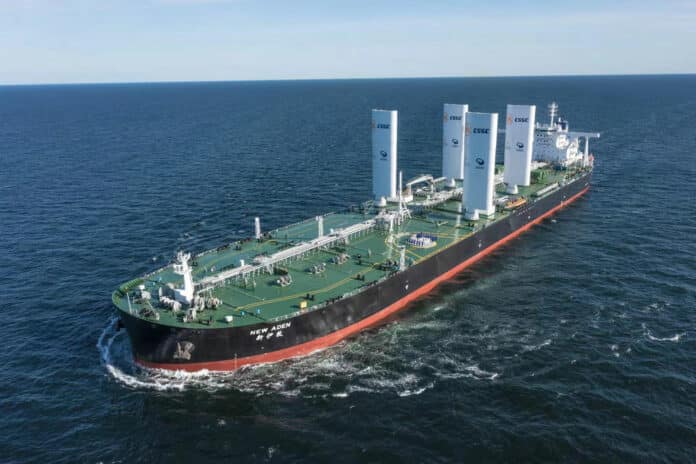China Classification Society (CCS) has announced the delivery and naming ceremony of the vessel – the new generation M/V “New Aden.” Built by Dalian Shipbuilding Industry for China Merchant Energy Shipping (CMES), the vessel is featured with energy-conserving and environmentally-protective very large crude carrier (VLCC).
It has an outstanding overall performance such as optimization of operational performance of the ship, reduction of fuel consumption, and enhancement of sailing performance in wind and waves, which contribute well to safety and environment protection. According to the CCS Vice President Mr. Fan Qiang, the New Aden is one of the most advanced VLCCs ever built in China.
Launched on September 24, the supertanker has an overall Length of about 333 meters, a molded width of 60 meters, and a molded depth of 30 meters. It runs a relatively modest but groundbreaking wind power system.
The New Aden is equipped with four retractable wing sails, each having a height of 40 meters and presenting a 1200 square meter surface, mounted near the middle of the long deck. The sail blade is made of carbon fiber composite as a consequence of its low weight, high strength, and good corrosion resistance to the marine environment. These blades can be raised or lowered at the touch of a button.
The highly autonomous intelligent control system significantly improves the sail’s adaptability to the complex operating conditions of the vessel and the sail’s operation efficiency. This Aerofoil Sails Intelligent Control system can adjust the control strategy online according to real-time data such as the navigation environment. This system can constantly monitor the status of the power supply, communication self-check, hydraulic lifting, and electric rotation so that the fault source can be quickly located. This system is user-friendly and includes customers’ concerns as end-users and chances to participate in both developments of the operational panel and intelligent auxiliary function module.
The use of sail installations is expected to reduce average fuel consumption by more than 9.8% on the Middle East to the Far East route, cutting an estimated 2900 tons of CO2 emissions a year.
The New Aden meets the requirements of Harmonized Common Structural Rules (HCSR), the latest oxynitride and oxysulfide emission standards, Energy Efficiency Design Index (EEDI) and Energy Efficiency Existing Ship Index (EEXI), the EU Inventory of Hazardous Materials and ship recycling and the latest requirements that given by major oil giants, etc.
